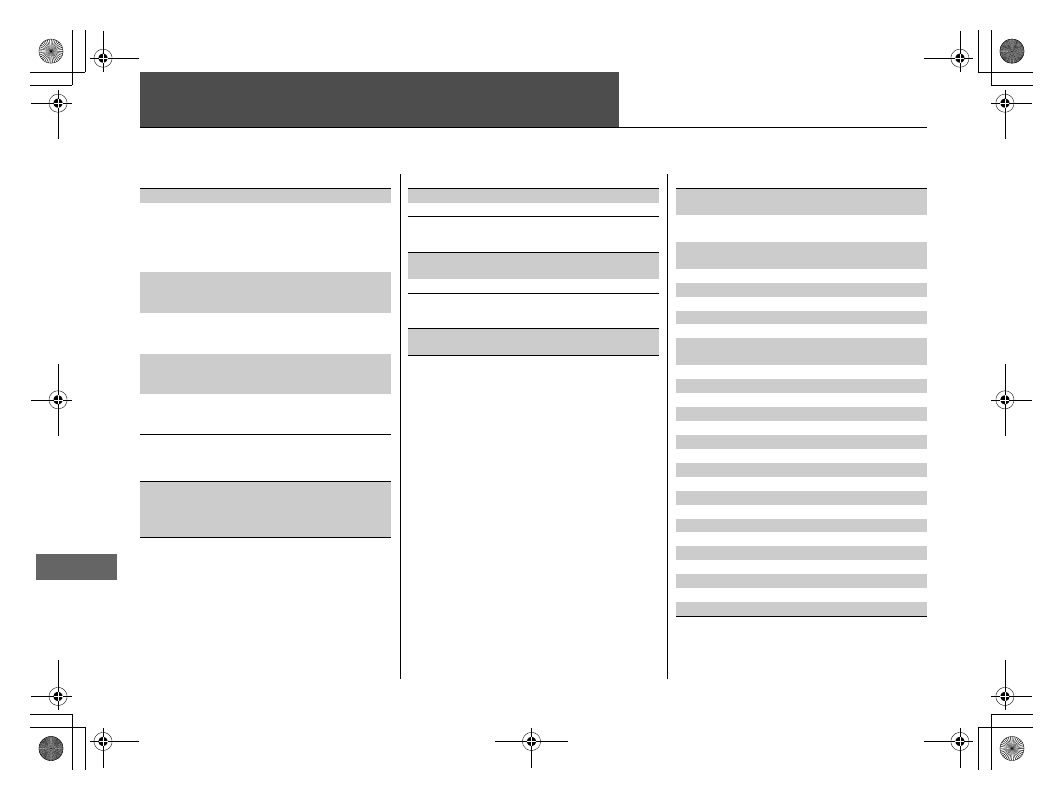Honda Odyssey (2019 year). Manual - part 47

740
Info
rm
ation
Specifications
■
Vehicle Specifications
*1: LX grade model
■
Air Conditioning
Model
Honda Odyssey
No. of Passengers:
Front
2
Rear
2nd Row 3 (2
*1
)
3rd Row 3
Total
8 (7
*1
)
Weights:
Gross Vehicle
Weight Rating
U.S.: 6,019 lbs (2,730 kg)
Canada: 2,730 kg
Gross Axle Weight
Rating (Front)
U.S.: 2,888 lbs (1,310 kg)
Canada: 1,310 kg
Gross Axle Weight
Rating (Rear)
U.S.: 3,230 lbs (1,465 kg)
Canada: 1,465 kg
Gross Combined
Weight Rating
U.S.: 8,565 lbs (3,885 kg)
Canada: 3,885 kg
Refrigerant Type
HFO-1234yf (R-1234yf)
Charge Quantity
20.3 - 22.0 oz (575 - 625 g)
Lubricant Type
ND-OIL14 (POE)
Quantity
7.3 - 8.2 cu-in (120 - 135 cm
3
)
■
Engine Specifications
■
Fuel
■
Washer Fluid
Displacement
212 cu-in (3,471 cm
3
)
Spark Plugs
NGK
DILZKR7B11G
Fuel:
Type
Unleaded gasoline, Pump octane number
of 87 or higher
Fuel Tank Capacity
19.5 US gal (73.8 L)
Tank Capacity
U.S.: 2.6 US qt (2.5 L)
Canada: 4.8 US qt (4.5 L)
■
Light Bulbs
*1: LX and LX-HS grade models
*2: EX, EXL, EXL-NR, EX-R, EXLNAV, and EXLRES grade models
*3: ELITE and TOURING grade models
*4: EX-R, EXL-NR, EXLNAV, EXLRES, ELITE, and TOURING grade models
*5: ELITE and Canadian TOURING grade models
Headlights (Low Beam)
55W (H11)
*1, *2
LED
*3
Headlights (High Beam)
60W (HB3)
*1, *2
LED
*3
Fog Lights
35W (H8)
*2
LED
*3
Front Turn Signal/Parking Lights
28/8W (Amber)
*1
Front Turn Signal Lights
28/8W (Amber)
*2, *3
Front Side Marker Lights
3CP
Parking/Daytime Running Lights
LED
*2, *3
Daytime Running Lights
60W (HB3)
*1
Side Turn Signal Lights
(on Door Mirrors)
LED
*2, *3
Brake Lights
21W
Rear Side Marker/Taillights
LED
Rear Turn Signal Lights
21W
Back-Up Lights
21W
Taillights
LED
High-Mount Brake Light
LED
Rear License Plate Light
LED
Map Lights (Front)
5W
Map Lights (Rear)
5W
Cargo Area Light
8W
Vanity Mirror Lights
1.4W
Door Courtesy Lights
3.8W (2CP)
Glove Box Light
1.4W
Foot Lights
LED
*5
Console Compartment Light
1.4W
*4
Door Inner Handle Lights
LED
*5
Instrument Panel Ambient Lights
LED
*5
Pass Through Light
LED
*5